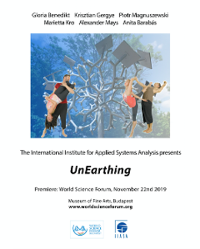UnEarthing
I. MOTIVATION
What might the world look like in 2050? Will small-scale, distributed facilities that harness renewable energy surrounded by trees dominate the landscape, or will there be large-scale solar farms, smart grids, and geo-engineering? There are competing solutions for what a sustainable world would look like. Why do we have such strong preferences for one set of solutions over the other?
How can we combine them constructively and develop a coherent and sustainable way forward that enables us to move towards a sustainable future?
After all, if we do not have an inclusive vision of where we can go, we cannot start walking.
II. PROCESS
A. Goal setting
The UnEarthing research and performance project was designed to simultaneously innovate and generate impact.
Innovation: When we think about the two different types of solutions science offers to transition into a sustainable future, we tend to think about two schools of thought that evolved in the 20th century: one focused on staying within the limits of our planet, the other on technology. The underlying values can however be traced to philosophies that evolved centuries earlier and are based on different understandings of how humans perceived their relationship to nature and their role in the world. The goal is to connect science – as we experience it today – to culture that has evolved throughout history, to derive a more holistic understanding of two worlds that are traditionally separated: the world of culture, which is based on value systems, and the wolrd of science, which is based on facts and data.
Impact: Can this holistic approach to looking at the world be useful for people to envision what a sustainable world could look like? Could it help them make better - informed decisions when it comes to employing the solutions science provides through live interaction during the performance? Can applying aspects of cultural theory be helpful in such a process?
B. Researching culture that led to science
Lead: Gloria Benedikt. Input: Piotr Magnuszwski and Wei Liu
How is it possible to establish a lens connecting the past – spanning the evolution of man from the agricultural revolution, through the evolution of different philosophies around the world, all the way to the scientific revolution? To answer this question and lay foundations for the performance segment, three sources in particular served as inspiration: two books, The Patterning Instinct (2017) by Jeremy Lent, Prophets and Wizards (2018) by Charles C Mann, and the mechanisms of cultural theory.
Mann bases the different scientific schools of thought on two 20th century founding fathers: William Vogt, the intellectual forefather of the environmental movement, who advocated what is known today as ‘living within planetary boundaries’, and Norman Borlaug, the intellectual forefather of ‘techno-optimism’, who advocated that science and technology, the fruits of human ingenuity, will solve the problems humanity faces. While this analysis is very helpful in terms of understanding the types of solutions on offer today, and demonstrates how science is not value free since every human being, including scientists, gravitates to one or the other school of thought based on his or her values, starting the story mid-last century did not seem enough. These schools of thought were based on assumptions that were deeply embedded in the cultural understanding of our role as humans on this planet: is it to take care of, or to conquer the planet?
Lent’s book drew a convincing trajectory of these two ideas through history. The former could be found in philosophies across the world, while the latter was unique to Greek philosophy and eventually led to the scientific revolution.
Cultural theory advocates that values are rooted in world-views, and when looking at the world through the worldview lens, the notion of plural solutions is apparent. When applying this approach to the solutions offered by the two scientific world-views, it becomes clear that both are logical, and that both have strengths and weaknesses.
Cultural theory proposes that there are no ‘elegant’ long-term solutions, but there are robust, ‘clumsy’ solutions that emerge from compromise. The weakness of Lent’s analysis, which is written from the environmentalist worldview, can be seen when employing the lens of world-views. The goal of this work was to avoid adopting a worldview and stay neutral. A difficult task, as will be become clear later in the process.
C. Choosing the title
Lead: Gloria Benedikt
The title UnEarthing was chosen due to its double meaning.
In the first instance, UnEarthing could mean resource depletion, climate change, biodiversity loss, and ecosystem collapse – a rapidly accumulating list of crises, which may evoke fear of a pending apocalypse. The original meaning of this ancient Greek word is however ‘when things reveal themselves’. A synonym for revealing is ‘unearthing’.
The second meaning is ‘finding something that has been hidden or lost for some time’. In this regard, the piece aims to reveal the cultural foundations of the solutions on offer today, and to uncover how they could generate a sustainable future led by humans.
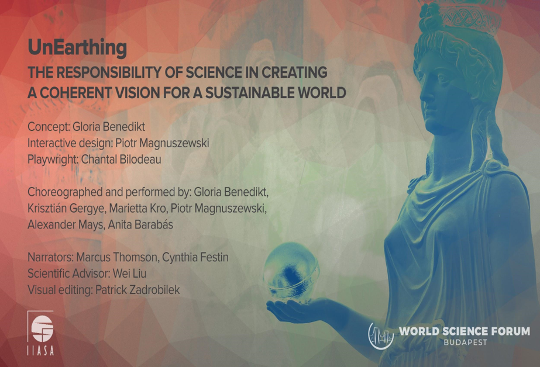
© IIASA
D. Text composition
Lead: Chantal Bilodeau. Review/input: Gloria Benedikt and Piotr Magnuszewski
The next step in the process was to create a story for the performance part of the projetc based on the gathered information. In the first draft, playwright Chantal Bilodeau attempted to tell the story of the evolution of man from the agricultural revolution through the evolution of different philosophies that led to the scientific revolution, and then to the present.
The prologue starts with the narrator telling the story:
“First, there was a world of bounty. With everything we could possibly want there for the taking. And take, we did: from giant marsupials to saber-tooth tigers, from camels to mastodons, slowly, without realising it, we caused massive extinctions everywhere we went. This was thousands of years ago. Then, after creating this problem, we created the technology to solve it. Agriculture was born.”
Magnuszewski however detected a bias in the first version of the story. Similar to Lent’s approach, the story was already being told through an environmentalist lens. Even with the best intention of objectivity Benedikt and Bilodeau did not notice that they were taking sides. After another round of discussions, they agreed that two narrators were needed. Narrator one would tell the story from the perspective of a person who sees the role of man as taking care of the planet, while narrator two would depict man as the unique species who could bring progress through technological innovation:
NARRATOR 1
First, there was a world of bounty. With everything we could possibly want there for the taking. And take, we did: from giant marsupials to saber-tooth tigers, from camels to mastodons, slowly, without realizing it, we caused massive extinctions everywhere we went. This was thousands of years ago. But after creating the problem, we invented a way to solve it. Agriculture was born.
MASTER OF GAME
This is a nice story. But is it the entire story or is there another way to look at what happened? What if there is a different perspective?
NARRATOR 2
First, there was a harsh environment. With danger around every corner. In order to survive, we had to fight giant marsupials and saber-tooth tigers, camels and mastodons. But we were smarter than them. We learned to work together and pass on our knowledge to the next generations. We even designed a new technology so we could finally stop wandering. Agriculture was born.
The story then continues with the two narrators alternating in telling the story, sometimes disagreeing and asking to go back in time to retell the story from a different perspective until they arrive in the present where the audience is presented with two sets of solutions:
NARRATOR 1
For thousands of years, we have pondered over our role and our relationship to the Earth. Today, it is interesting to be alive at the exact moment when a crucial decision has to be made. Do we scale back and learn to live within the limits of our planet or do we rise up to the level of gods by engineering the weather?
NARRATOR 2
The result of our evolution is a greater understanding of how the world works. Equipped with this unprecedented scientific and technological know-how, we now have capacities we never had before. It is our responsibility to use these capacities wisely by contributing to the wellbeing of all human beings.
ENVIRONMENTALIST 1
We care about the Earth. We care about its inhabitants. We’ve always managed to adapt and survive.
TECHNO-OPTIMIST 1
We’re creative. We’re smart. We’ve figured out ways to feed millions before.
ENVIRONMENTALIST 2
Our greatest gift is our ability to form community through meaningful connections.
TECHNO-OPTIMIST 2
Our greatest gift is our ability to innovate our way out of crises.
ENVIRONMENTALIST 1
We propose organic agriculture; reforming institutions and changing our habits around water –
ENVIRONMENTALIST 2
– small scale, distributed facilities that harness renewable energy; and reforestation and afforestation. But first of all – less consumption!
TECHNO-OPTIMIST 1
We propose crop modification; desalination and technological innovations –
TECHNO-OPTIMIST 2
– large-scale solar farms, superconductivity, and smart grids; and geo-engineering.
E. Script composition
Lead: Gloria Benedikt. Review/input: Wei Liu and Piotr Magnuszewski
The next step in the process was converting the text into a script. Scene 1 to 4 are performance driven, scenes 5 and 6 are interactive, and scene 7 is conclusive.
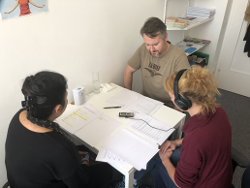
Narrators Marcus Thomson and Cynthia Festin record the text © IIASA
Prologue: The narrators set the scene
Scene 1: Agriculture is born, people appeal to the gods for rain – a common characteristic in every ancient culture throughout the world.
Scene 2: The journey continues to different emerging philosophies, revealing each philosophy’s understanding of man’s relationship to nature. It becomes apparent that all see man as part of nature/ the ecosystem until Greek philosophy is encountered and a new idea emerges: man has the unique capacity to understand the laws of nature, and by understanding the laws of nature, can rule the world more than any other species.
Scene 3: This idea brings new findings to change the world: the laws of logic, mathematics, and eventually the scientific revolution.
Scene 4: The scientific revolution leads to the industrial revolution and brings unprecedented progress that leads us to the present and brings up a very old question: rather than appealing to gods to influence the weather, can we use technology to influence the weather instead?
The role of the four performers was clearly established. They represent humans throughout history: two gravitate towards nature based understanding, and the other two towards technology. During the performance part of the production, they are mainly dancing with little text, but once they arrive in the present, they become actors, advocating for the two types of solutions science has to offer.
Music and visuals were chosen to strengthen the storyline.
The artists were familiarized with the script.
The text was recorded with two narrators.
The rehearsal sound file combining text and music was prepared.
F. Rehearsal period one
Lead: Gloria Benedikt, Krisztián Gergye, Marietta Kro, and Alexander Mays
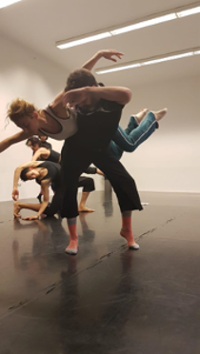
Cast in rehearsal © IIASA
During this phase, the four dancers had to translate the script into choreography. Their first task before collective rehearsals began was to come up with two short solos where they invoke the rain gods in different cultures: Oya (Africa), Tialoc (Atzteks), Indra (India), Freyr (Northern Europe), Horus (Egypt), Chak (Maya), Adat (Middle East), and Jupiter (South-east Europe). The four scenes were drafted over the course of four rehearsal days. Unlike conventional dance, where the choreography is set to certain counts in the music, the text at times had to serve as guidance and movements had to correspond to certain words rather than counts. At the end of rehearsal period one, the trailer was recorded on green screen to enable the adding of any kind of background at a later stage.
Trailer and press release published
G. Developing the interactive segment
Lead: Piotr Magnuszewski. Input: Gloria Benedikt
The interactive segment was designed to offer a possibility to experience the dilemmas resulting from alternative worldviews conveyed during the performance parts. In scene 6, the audience is asked to negotiate a new binding climate agreement, given that Paris is not working. All participants have to choose between the two worldviews (techno-optimism or self-restraint). Those with similar mindsets are then asked to form small groups to discuss specific solutions. To increase the realism of the simulation a third worldview is added–those who do not agree that there is a problem to start with and thus do not believe any action is necessary at all. This group may be actively denying the science or the urgency of the problem or they may be disengaged.
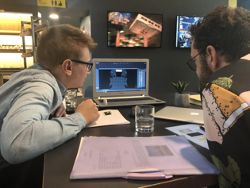
Lighting technician discusses Course of Action with Krisztian Gergye © IIASA
A group of scientists present at the World Science Forum was recruited to represent this third worldview and act as protesters to disturb the negotiations, advocate for fossil fuels, and express their disengagement and/or denial of climate change. During the discussions, the protesters trying to preserve the ‘status quo’ push the other two groups to continue business as usual–they want to keep their jobs and entertainment enabled by fossil fuels. Despite of these disruptions, participants discussing solutions are asked to submit their solutions using an online platform (SLIDO) so that these can be presented on the main screen. Since the solutions were created within like-minded groups, they tend to only emphasize one worldview and therefore the dancers (who represent the decision makers) reject these suggestions. In scene 7, the second round of discussions, the participants are asked to form mixed worldview groups and to formulate the solutions again. This leads to the creation of more balanced solutions that are easier for decision makers to accept.
H. Rehearsal period two
Lead: Gloria Benedikt/Piotr Magnuszewski Premiere input/review: Anita Barabas, Krisztián Gergye, Marietta Kro and Alexander Mays
During this phase of the project, sound and light files were finalized, and sound and light cues written. Scenes 1 to 4 were revised, scenes 5 and 6 were drafted, and scene 7 choreographed. Particular challenges for the dancers entailed developing the skill to switch from dancing to acting.
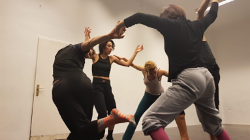
Cast in rehearsal © IIASA
Furthermore, when rehearsing the entire performance, the performers needed to simulate the interactive scenes as much as possible without knowing exactly how the audience would react. The scientists who volunteered to act as protesters were briefed. The entire cast, including the protesters were assembled for the first time during the technical- and dress rehearsal.
III. OUTCOMES & DISSEMINATIONS
Premiere
UnEarthing premiered as a special session at the 2019 World Science Forum. A stage was built in the Museum of Fine Arts and the performance was live streamed.
A summary video of the recording was distributed through social media. Further performances are currently being planned.
UnEarthing presents an innovative take and presents a fresh history of humanity's role in sustainability. IIASA's Science and Art Project Leader, Gloria Benedikt, replaces the reductionist theory that early hunter-gatherer societies "managed" dwindling natural resources through the development of agriculture, which led to the development of modern civilisation and the post-Enlightenment economic exploitation of the environment through technology. This nuanced work provides a global picture of science through the ages, using metaphors of ancient world religions to reflect contemporary disciplinary perspectives that explain the natural world, as well as the evolving relationship between humankind and nature.
As a work of performance art, UnEarthing is beautiful and compelling and stands on its own as an artistic expression. But as a research approach, it provides an effective and powerful tool of science communication by challenging its audience to confront the tight coupling of bias, power, and politics that are embedded in today's sustainability issues. In particular it uses a confrontational device that forces the audience--in this case, the global elite in science policy and diplomacy--to choose sides between Technology and Nature. The indecision and tension is palpable in a room filled by individuals reluctant to make their choice public without equivocation. It is the kind of electrifying moment that turns the performance from an innovative form of science communication into fine art, because it forces viewers to engage directly, examine personal beliefs, and make a philosophical (if not ethical) commitment. But then it goes deeper into the group's psyche by tearing apart the many facile solutions to the environmental crisis that are offered up by the audience, via UnEarthing's social media tool, sli.do. The artists continue to put pressure on the audience by corralling them into a series of decisions, all the while compelling the individual to critically defend their own ideas.
At the end of this trial, exasperated members of the audience suggest sustainability solutions that include: "kill everyone," "let aliens come to our planet," "wipe out all humanity and start a new one," and "find another planet now." The troupe responds to this resigned attitude from the world's leaders in science policy with a spoken word poem that urges them to come together to protect the entire planet by using all of the tools avilable to humanity, and ends with an interactive dance piece that demonstrates dignity and grace in this common endeavor.
This is not how plenary sessions normally work! It is a powerful and engaging expression of science in society, examined through the lens of sustainability.
Merc Fox
Director of CODATA Center of Excellence in Data for Society at the University of Arizona
How might this work support the global transformation towards sustainability?
We need to be able to envision the future before we can start walking. This work helps to translate the options and solutions science offers into implementation by enabling the audience to understand how the past has led us to the present, and how their choices and actions in the present will shape the future.

IIASA Science and Arts Brochure
Case Studies
ON THE BLOG


